By Bonnie Cassen with Magella Blinksell
With Our Own Eyes is a new project helping folk in the Eurobodalla to record and share the climate changes they are seeing in their waterways, forests, oceans and backyards.
With a showcase of contributions launched during Eurobodalla’s River of Art Festival, the project features responses by Eurobodalla’s locals, artists, photographers, wildlife carers, and bushfire survivors.
A footpath style exhibition curated in shopfront and arcade windows outside the Rustic Pantry Whole Foods in Moruya’s main street showcases the project until Sunday 4th October.
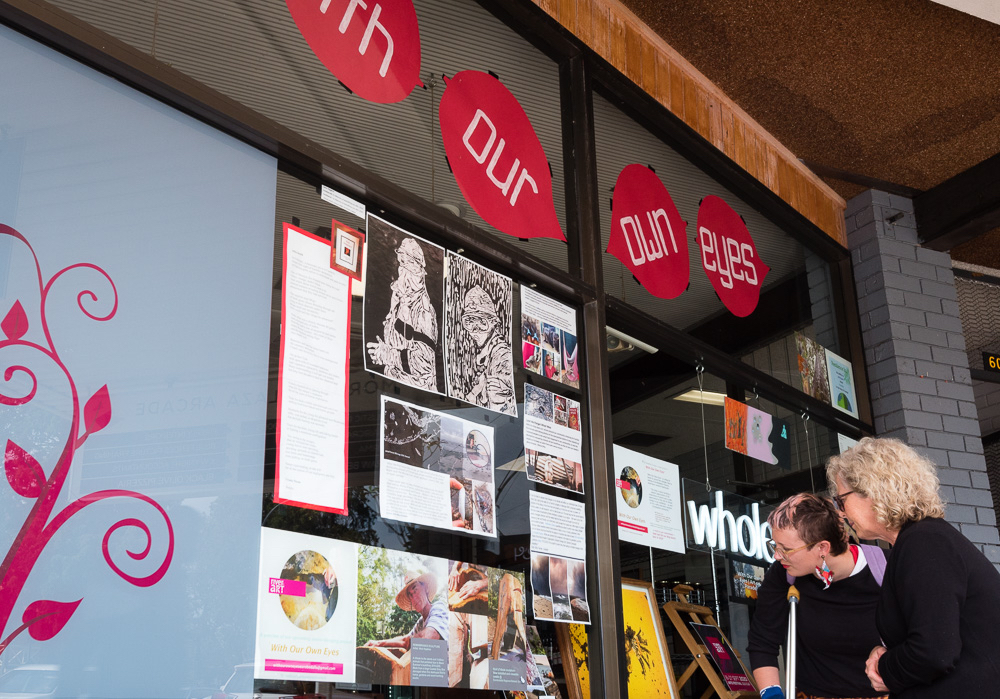
Artworks from the project line the windows in this footpath style exhibition.
Photo credit: Gillianne Tedder
Art, stories, personal responses, recollections, photo essays, poetry and climate haiku fill the windows. If you live in the area or travel through Eurobodalla it’s worth taking a peek.
Black Summer’s cataclysmic fires were the impetus for creating With Our Own Eyes says co-coordinator and digital storyteller, Magella Blinksell.
With the ‘Forever Fires’ raging mercilessly for over 70 days along the South East, burning almost 80 per cent of the Eurobodalla shire, claiming three lives and destroying almost 500 homes, Magella believes it was obvious that a community project was needed to record the changes that locals have been seeing with their own eyes.
“Like many bushfire affected communities, we are still making sense of what we have seen during these unprecedented fire events,” she says.
“We’ve been lobbed into new times, 2010-2019 was the warmest decade on record. And as we experienced firsthand, the 2019-2020 fire season was not a normal fire season. It was a ferocious beast that hung around forever, surrounding us.”
“With little time to process what we’ve seen in the lead-up and during the fires, and then with a pandemic and floods soon after on our doorstep, we’ve found ourselves in a kind of liminal or in-between time. It’s been hard for people in our community to come together, to air and to share like they would normally do.”
“We’ve never seen something of this magnitude or impact. And in many ways Covid-19 has disrupted and suspended the normal processes communities usually go through when commiserating and grieving together, and when catching their breath. And then there’s how do we make sense of the changes we are seeing in our local environment and climate?” says Magella.
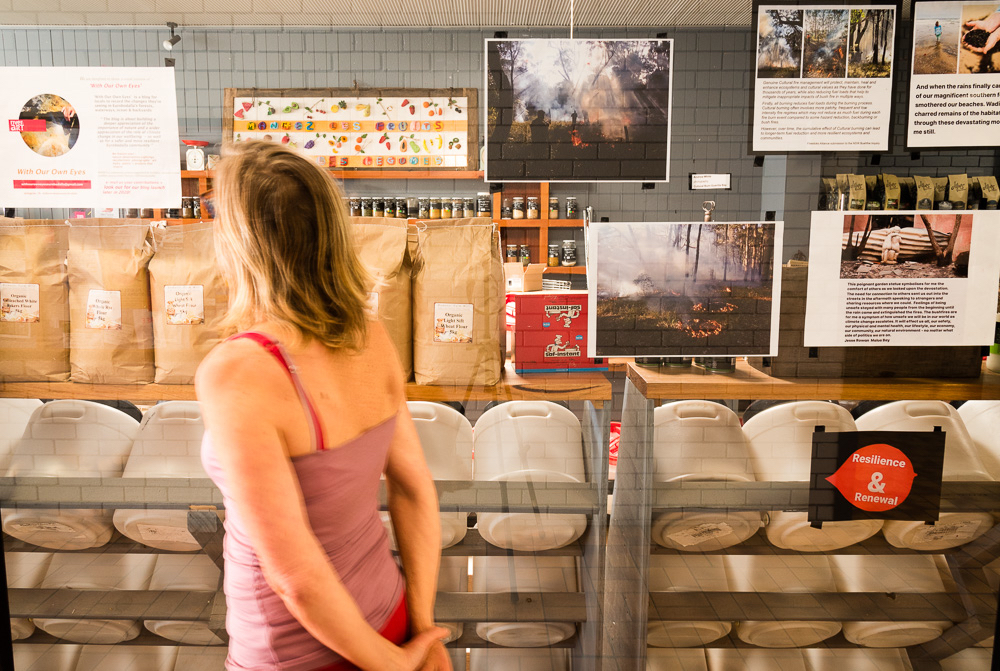
An emotive exhibition set against a backdrop of grocery ordinariness.
Photo credit: Gillianne Tedder
The window display in Moruya and its parent project - a soon to be launched With Our Own Eyes web blog - are integral to drawing a richer portrait and a shared understanding of what people in Eurobodalla experience and observe firsthand.
“It can offer a wider understanding of what we are dealing with locally, and what we can do. With Our Own Eyes is essentially our local story told through our eyes,” she says.
Ironically the destruction of last summer and the strictures of Covid have drawn many locals in Eurobodalla back into an even deeper valuing of local wildlife and nature – and an appreciation of nature’s role in a safer and more resilient Eurobodalla community.
The project’s team includes former teacher Lyn Smith, and Rosedale bushfire survivor Jack Egan who defended and lost his home on the morning of New Year’s Eve in one of the Currowan Fire’s most treacherous firestorms.

Jillian Edwards image. Hakea, catches some precious native bees deep in the act of pollination. 
Jenni Knight's image. A stunning photo of the glossy black cockatoo, currently listed as vulnerable in NSW, the bushfires have destroyed vast areas of their habitat, threatening their survival even further.
Holding close the precious natural world that gives joy and solace - and which ultimately sustains us - is a key element of the project. Jack Egan is working with locals curating their nature observations.
“Climate change is happening fast, too fast for many animals and plants to adapt to by ordinary evolution. So, those have to either migrate south or uphill to cooler climates. But some species will already be at the limit of their range. We have to watch out for them with our own eyes and help them out.” Jack notes.
“Our species, homo sapiens, has caused this quick climate change. We have to help the plants and animals with whom we share this planet to get through as best we, and they, can.”
The web blog is ongoing, to act as a holding place for contributions from the Eurobodalla community as well as archiving and sharing the nature observations and sightings locals email in. Twitchers, surfers, gardeners, kayakers, beekeepers, farmers, divers, oyster farmers, nature lovers and all who like to dream, watch and listen, and notice from their veranda or back yard, are encouraged to be a part of this growing project.
With Our Own Eyes also features other projects that the community sees the benefit of with their own eyes.
This is a project to watch, as it pioneers a web blog for the Eurobodalla, offering inspiration, support and local knowledge forward.
Artist tour with Magella Blinksell
The New Bush Telegraph asked Magella Blinksell to walk us through some of the works and recollections on display. The artists descriptions below are Magella’s own words.
Even if you can’t get to the With Our Own Eyes display in Moruya in person, these captivating images will take you through an important story of Eurobodalla’s summer of devastation and the steps taken by locals towards recovery. We will also be covering the web blog’s launch later this year.
Cathie Cahill
A truly iconic oil painting made with burnt charcoal and collage, Black Summer – After the Fire was created by part-time teacher and farmer, Cathie Cahill. The painting captures the endless horizons of burnt forests she drove through, to the west of Moruya.
Cathy hadn’t painted for years, friends were unaware of her talent, but her self-expression was spotted on Facebook, and it quickly became a focal point for the With Our Own Eyes display.
You can almost feel the depth of forest loss stretching across the valley and over the mountains beyond.
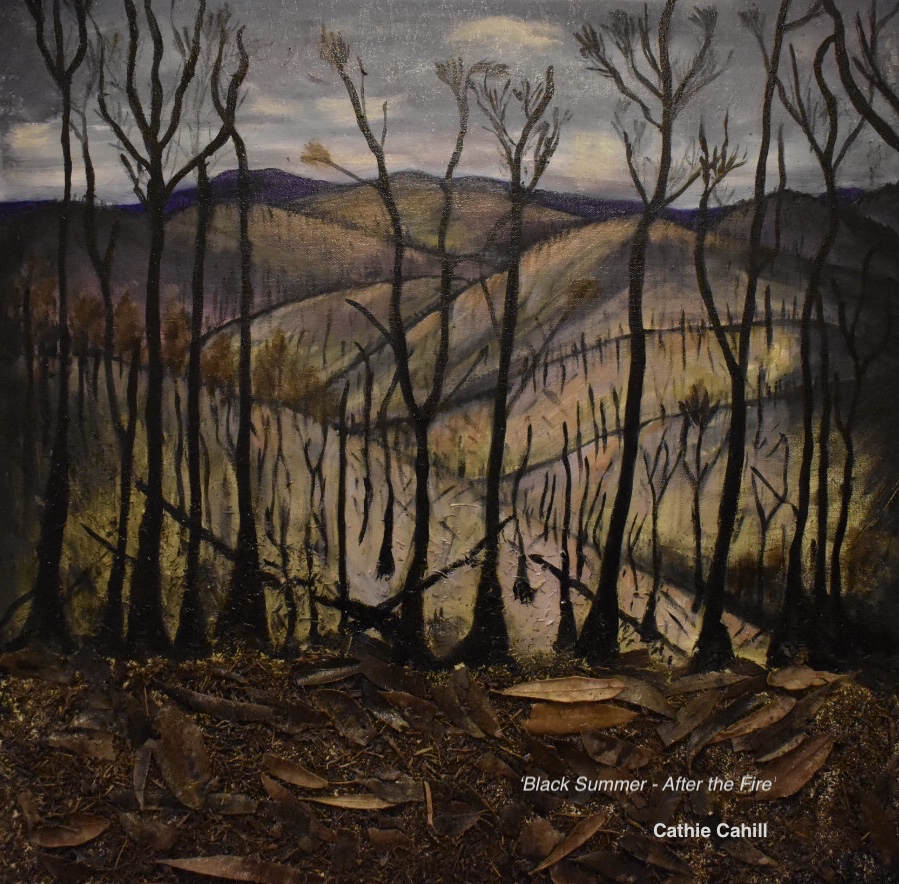
Cathie Cahill – Black Summer - After the Fire.
Toby Whitelaw
Local photographer Toby Whitelaw has two compelling and poignant photographs on show. Both are framed with timber reclaimed from fire-ravaged Mogo. Visually arresting, they offer a searing testimony to the devastation of last summer.
Toby has been observing with keenly honed nature lovers and artist's eyes long before the fires. And now in the wake of the 'Forever Fires' he has shared a number of his works with the With Our Own Eyes project.
The stark image of the dead currawong engulfed in the too-familiar blaze of a yellow orange existence, draws us in. We see into the scale and intensity of the fire and into the future before us, if the ecological disaster facing us is not addressed.
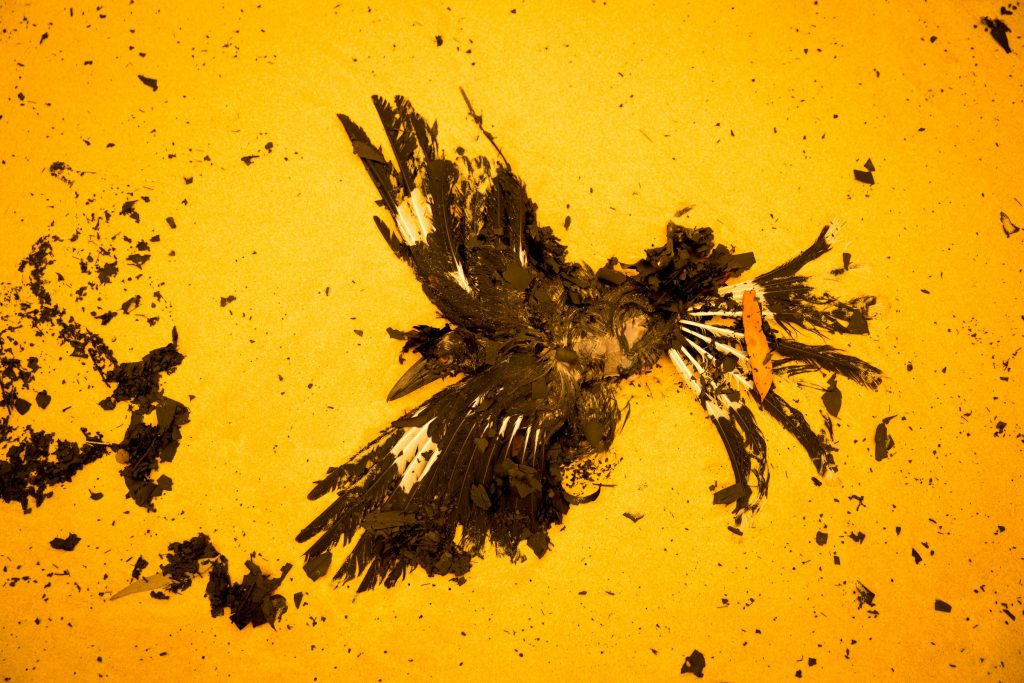
Currowan Currawong by Toby Whitelaw
Julie Mia Holmes
Printmaker and bookseller, Julie Mia Holmes presents a series of linocut prints and photos documenting the coastline after the bushfires.
Combing and scouring the rock pools of Eurobodalla’s coastline to make her art, Julie has memorialised the constant ‘burnt tide’ that lines Eurobodalla’s beaches each large swell, in large linocuts and ghost prints.
Burnt Offerings 2.0 brings out the keenly attuned attention of her perceptive eyes; tiny details, microscopic and microcosmic. Julie’s profound love of nature and her act of deep witnessing are inscribed in every line, every texture, every imperfection.
With blackened beaches, blackened life, still with us every single day, we are reminded of the summer that changed everything, and which we cannot forget.

Burnt Offerings 2.0 by Julia Mia Holmes, linocut, 2020
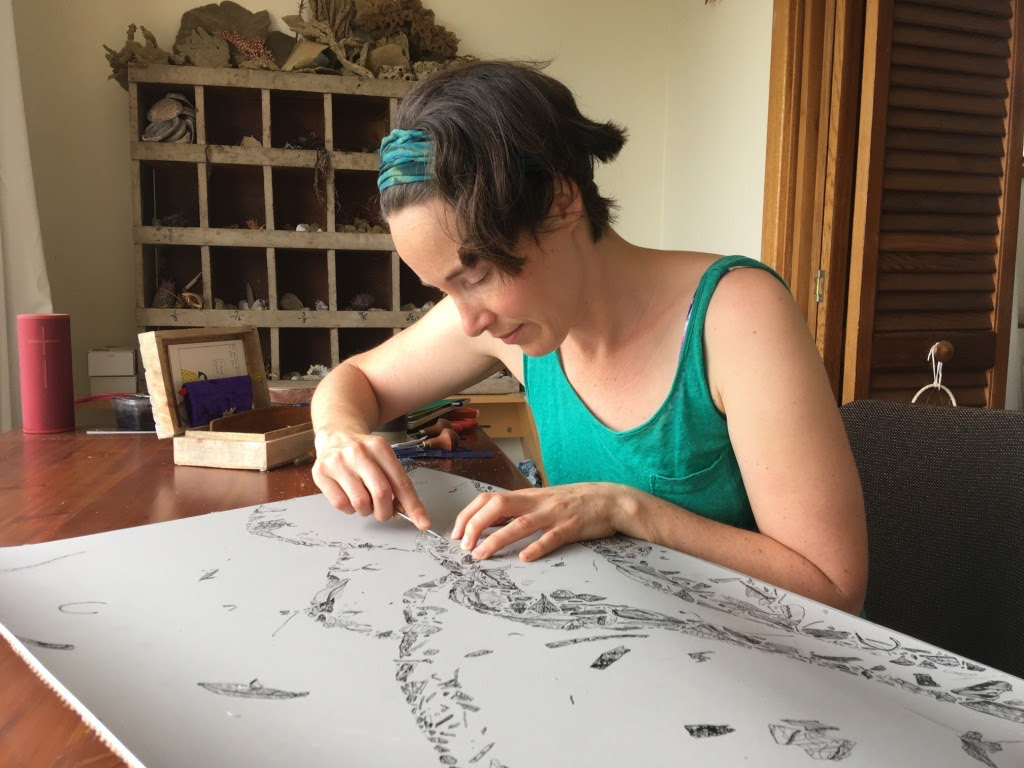
Photos by Julia Mia Holmes
Andrew White
Cultural Burn practitioner Andrew White’s sumptuous photography captures the gentle sense of connection and renewal – and the healing – of a cultural burn performed on private land at Guerilla Bay last month.
I was fortunate enough to see this cool burn and to witness the incredible knowledge and care for country that we can all embrace.
The fire in this photo is tame, controlled, nurturing and encompasses the voices of traditional wisdom. The totems of the land are elsewhere, their natural flow of life taking them from this immediate surround.
I love how this work captures how cultural burning works with, and for country, using fire slowly, carefully, to renew life and growth, to downturn the summer risks that grew up through the prior seasons, and to combat the harshness of the extreme temperatures yet to surface in our new climate-disrupted world.
Smoke drifts across the landscape, ancestral spirit cares and observes Indigenous practices – sacred, ritualistic – pragmatic, careful, life-giving and measured.
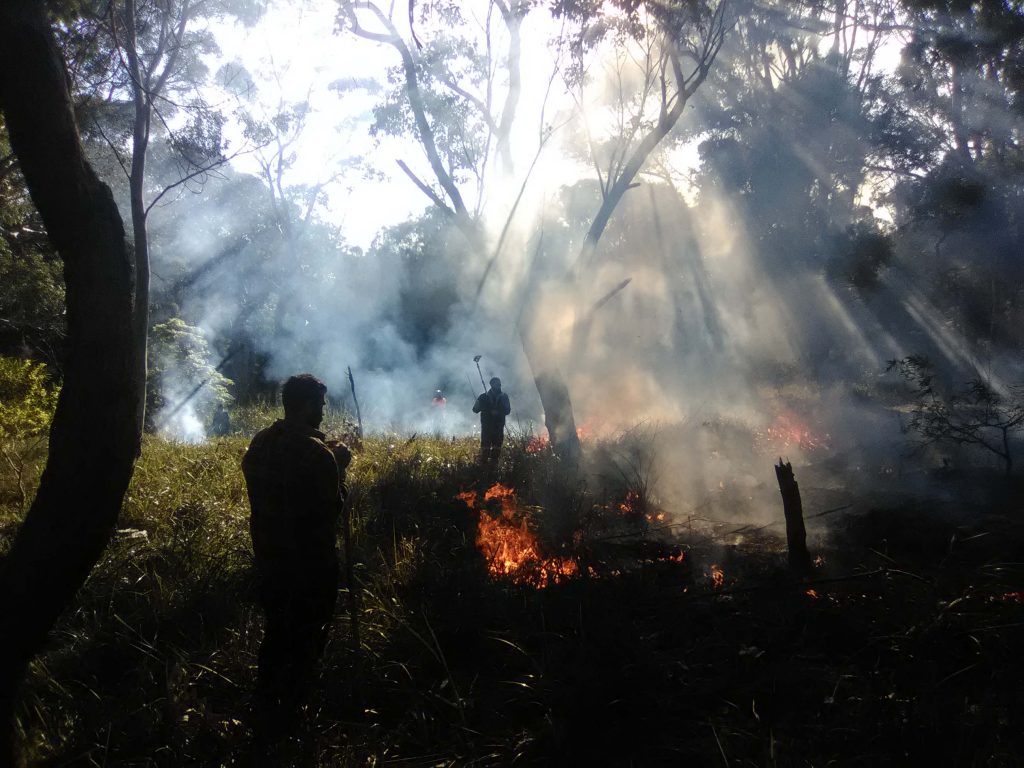
Cultural Burn 24th August 2020, photograph by Andrew White
Jess Higgins and Katherine White
Jess Higgins – now a Canberra-based printmaker and a Tuross girl who almost lost her artwork during the fires – displays relief cuts of a water bombing helicopter and the RFS fire fighters who worked tirelessly to protect the community and homes. Paired with climate haiku by artist Katherine White, they drive home how personal and epic, (and how local) changes to our climate are.
In Overhead Jess Higgins documents the horror of the fires through the memories that her bold helicopter image brings to surface. The shock and terror of the fires, the endless roar of helicopters and sirens, the visuals of blackened skies and summer’s sensory overload are evoked. All expressed so simply through a monotone depiction of the huge mis-shaped chopper as the saviour.
Katherine White’s Haiku places us firmly in the here and now of reliving our experiences of last summer. The words, simple but ever so carefully chosen, weave together, opening our entire being to the true meaning behind the loss.
Perhaps only those who experienced the daily trauma - over two months of what locals now call the ‘Forever Fire’, can know its emotional weight and length. A seeming eternity as the Currowan fire danced dangerously around Batemans Bay and Moruya, skipping out and launching itself viciously and indiscriminately at towns, streets and the shire’s corners, raging its deadly war against existence, while the Badja and Deua Fires towered.
Katherine’s gentle haiku words help to breach the gap and bring the viewer into her world for a short while.
In Untitled #3 (In memory of everything you did) Jess Higgins contrasts a fully protected firefighter against the forest that they have been indicted to protect. The forest appears to be weeping, while the firefighter stands frozen, goggles shielding any clues as to their emotions, as they carry out their task, under enormous pressure and a sense of duty.
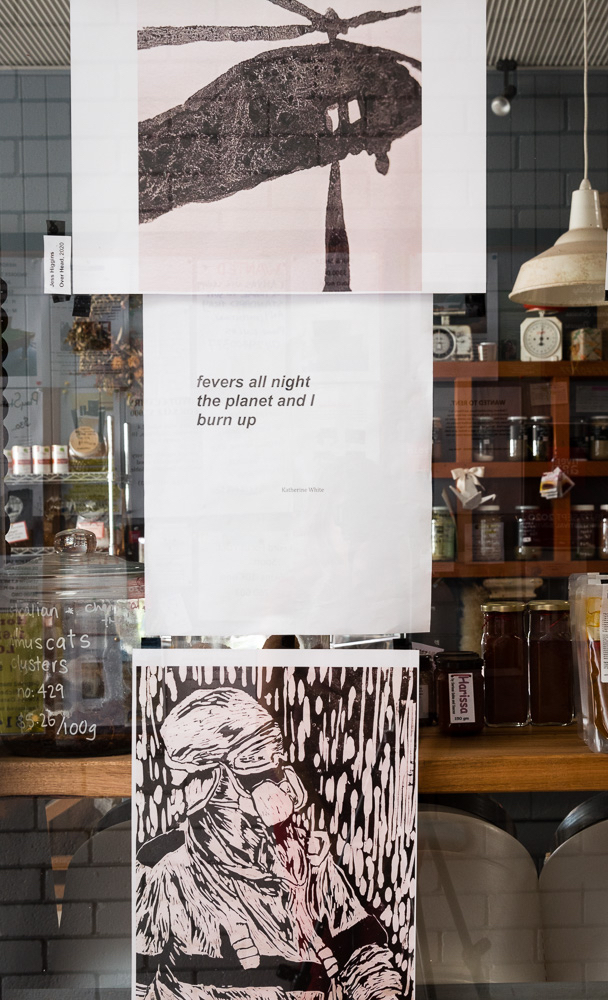
Jess Higgins - Overhead (top image). Katherine White - Haiku (middle). Jess Higgins - Untitled #3 - In memory of everything you did (bottom image), Relief print on Hosho paper.
Jenni Knight and Jillian Edwards
Jenni Knight and Jillian Edwards photographs draw out the macro beauty and the micro detail of Eurobodalla’s flora, its marine life and birdlife. These works were captured as they roamed through their favourite places preserving life-affirming moments with cameras and mobile phones in hand. We’ve featured them as decals on the shop front windows of the ‘gallery’ space.
By capturing the creatures and plant life in their natural habitat, we see first-hand what is at risk, and what we stand to lose as our warming planet takes its toll on the biodiversity of our land. All of life is interconnected - one species reliant on the next for their mutual survival, humans at the top of the chain, more vulnerable than first realised, unable to exist in a fractured world. We can take joy and nurture from the beauty that surrounds us, and its invitation to keep it - and ourselves- safe.
Julie Taylor Mills and Jesse Rowan
There are sobering stories from Meringo – from Wires wildlife carer Julie Taylor Mills – and from Canberra bushfire survivor and Malua Bay resident Jesse Rowan, part of an extensive documentation of the fires’ impacts on residents, homeowners, infrastructure, habitats, and wildlife in Eurobodalla.
Julie Taylor Mill’s perspective comes from a place of loss and care. Lost wildlife, lost forests and lost food sources. They are filed from her viewpoint as a wildlife carer.
We see her palms holding ash on Meringo beach, the hands that have nursed and tended injured joeys, wallabies, kangaroos, gliders, birds and reptiles. The stains of the mega fires leaving their mark for all to see, linger after what seems a lifetime ago, yet was only last summer.
Still unfolding, we are reminded that the ramifications tip forth into less visible realms. The residue of burnt forests and fauna causing ongoing harm to sea life - to the crustaceans of the ocean, the copepods, ostracods, crabs and lobsters, not to mention, tiny krill and brine shrimp. This is a call to care, and to act. And to see the connections with our eyes opened.
Jesse Rowan’s visual story documents other facets of the catastrophic destruction that ravaged Eurobodalla. Jesse has recorded a meticulously documented photo archive of damaged infrastructure and possessions just after the fire front passed and she and her partner were able to leave their Malua Bay home, and the street, they defended.
What is recorded too, are the profound social and emotional losses that have been suffered.
A sense of what we once thought of as ‘normal’ has been lost, irrevocably erased. Our existential reassurances of ‘home’, and ‘safety’ - and ‘normal’ - are dissolved and burnt away.
Melted metals are twisted beyond recognition. Household crockery and utensils destroyed. Blackened twigs and matchsticks - where magnificent trees once stood. Once hotels, palaces even, to the creatures who checked in and out each day. Some escaped, more perished, silence echo’s where song and chatter once filled the walls.
Also worth mentioning here is Bodalla’s Ursula Nix, whose poetry chronicles the summer, putting words to pictures, story to visual, complementing the visual chain of events as they occur. Ursula’s words of poetry are included in the exhibition display and will be featured soon on the With Our Own Eyes blog and here in The New Bush Telegraph.


Golden Carmichael, Julie Armstrong and Nick Hopkins
It's been great to work creatively with Golden Carmichael's playful and quirky drawings, morphed into frog and mother nature decals and suspended in space against the glass window fronts. Simple, stylised, interconnecting humanness with nature, blending the boundaries, bursting with meaning and softly spoken truth.
Julie Armstrong's montages of Eurobodalla's beauty offer a joyful sense of awe and renewal, and the nurture we take from our environment. Intensity of colour, exquisite splendour, striking against a chord of disharmony, shading – hiding the darker aspects of negligence and blocking the light towards recovery. A shadow of prayer and hope embedded permanently into the roots and trunk of every tree.
Crafted from a half burnt coastal grey box felled after Nick Hopkins's home and workshop were destroyed at Malua Bay, Nick's Tribute sculpture memorialises the three million animals lost in the summer seasons’ fires. A long-time climate activist, Nick put his anger, hurt and despair into creating art, not just as an outlet, but as a message of the change needed, both by governments which resist the change, and the people who must demand it.
The sculpture has now found its 'forever home' in the Eurobodalla Regional Botanic Garden. Nick says it was important and therapeutic to make the sculpture and is grateful that it has been honoured in such a natural resting place nearby.
I feel like all these works offer such varied and unique ways of seeing and remembrance. And they offer a clarion call to look with our own eyes.
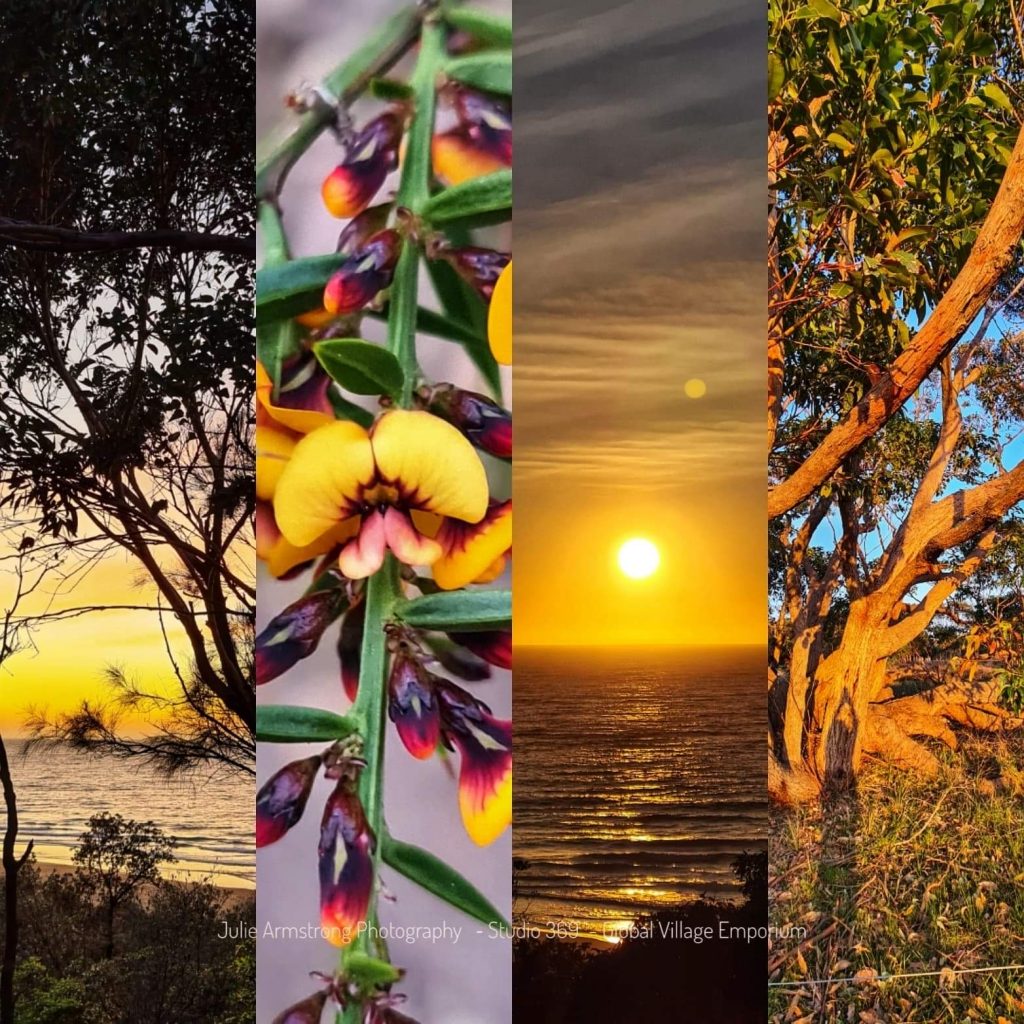
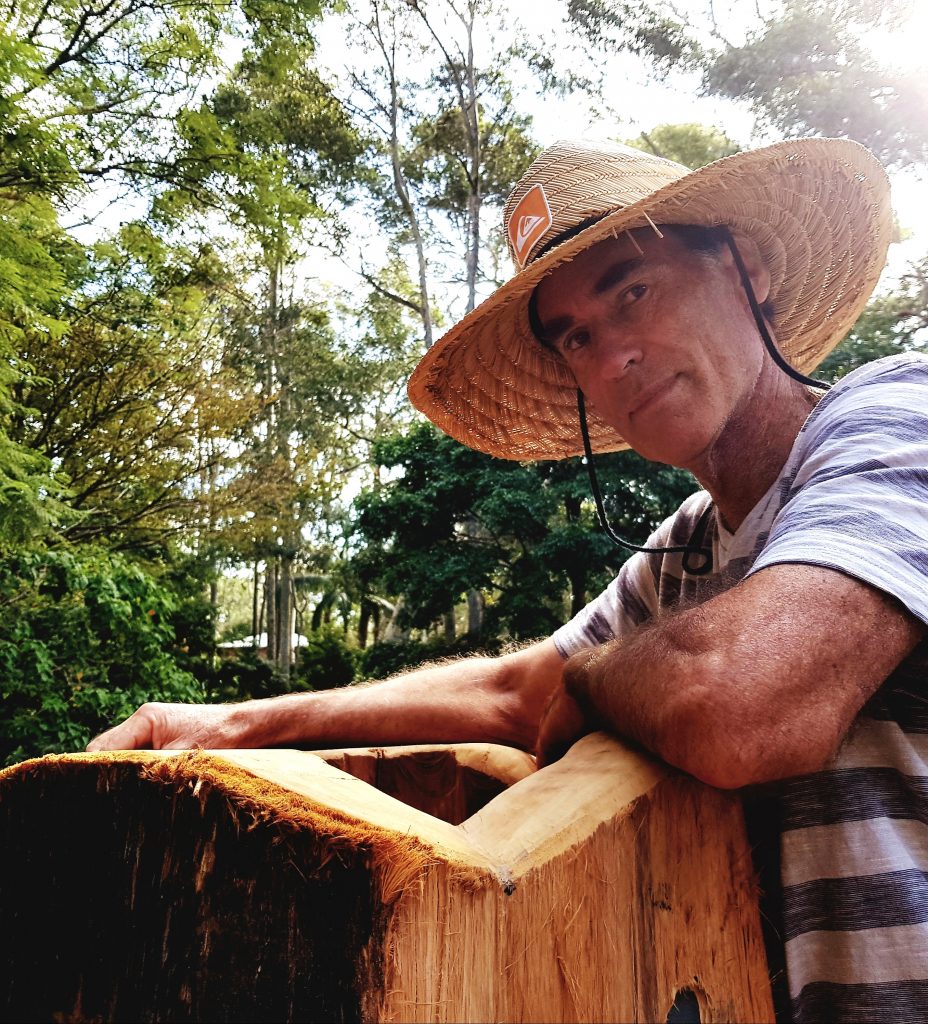
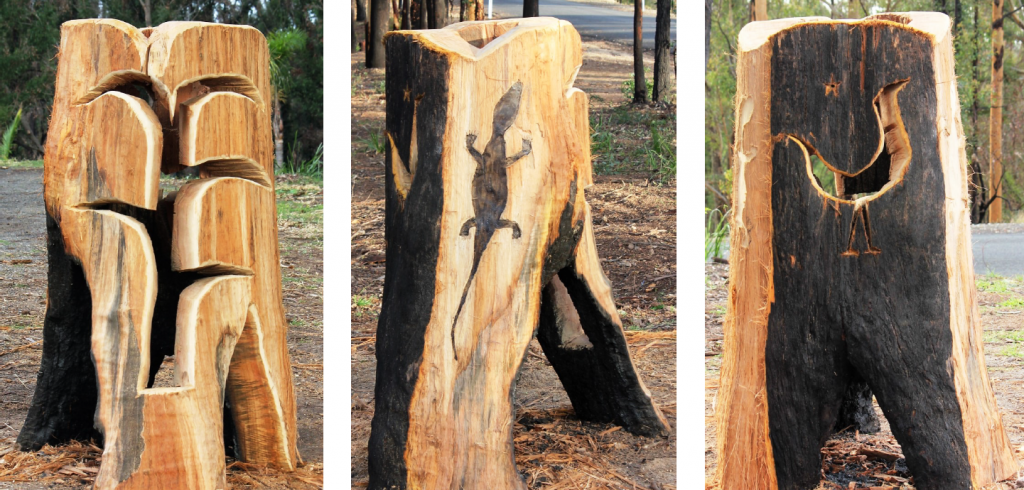
Poppy Mitchell
Beautiful pencil drawings by school student Poppy Mitchell, a kids' corner in the arcade window, and a mini showcase of projects that inspire, all remind us of what is important.
These are hopeful offerings. It's so important for us to look for these emblems of new and safer paths forward. It's always worth opening our eyes, seeing our local possibilities, and looking at our community's values and goals afresh.

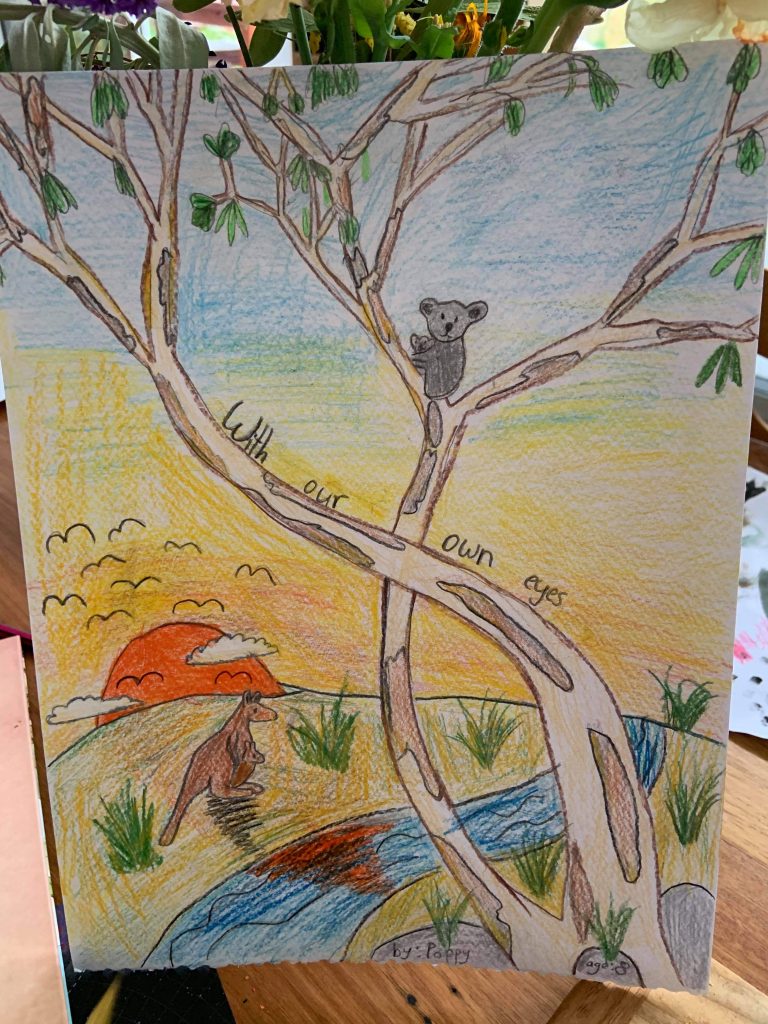
Art for advocacy and activism
The photos and artworks exhibited in the With Our Own Eyes project confirm arts ability to engage everyday people on the important issue of the climate and ecological emergency we face.
Photography and art make it accessible for anyone to document what they see in the environment, both the recovery and the damage. Many would not realise the degree of debris still covering beaches right along the south coast and the ash line visible after storms or swell; the north coast too. It will take some time to assess the extent of damage to coastal and wetland ecosystems, but the small critters matter too.
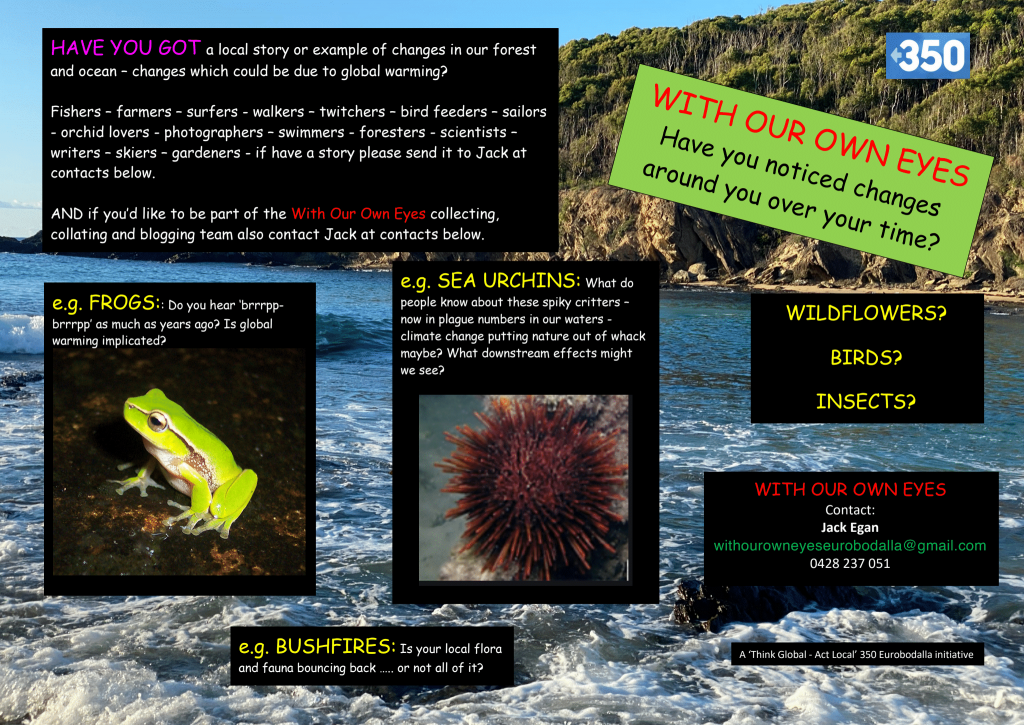
The With Our Own Eyes project is ongoing and everyone can get involved by observing the changes around you over time.
With Our Own Eyes is a community initiative supported by 350 Eurobodalla, bushfire survivors and wildlife carers. With Our own Eyes is currently open daily 10am to 4pm at The Rustic Pantry, Moruya and continues beyond the festival until the end of next week – Sunday 4th October.



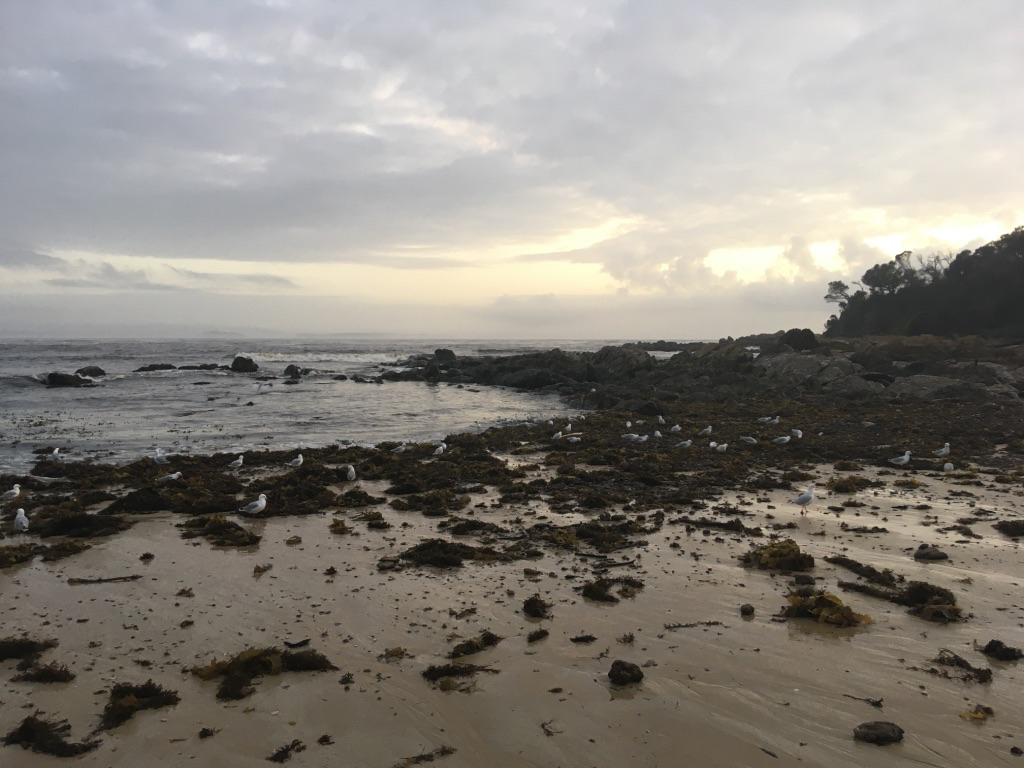



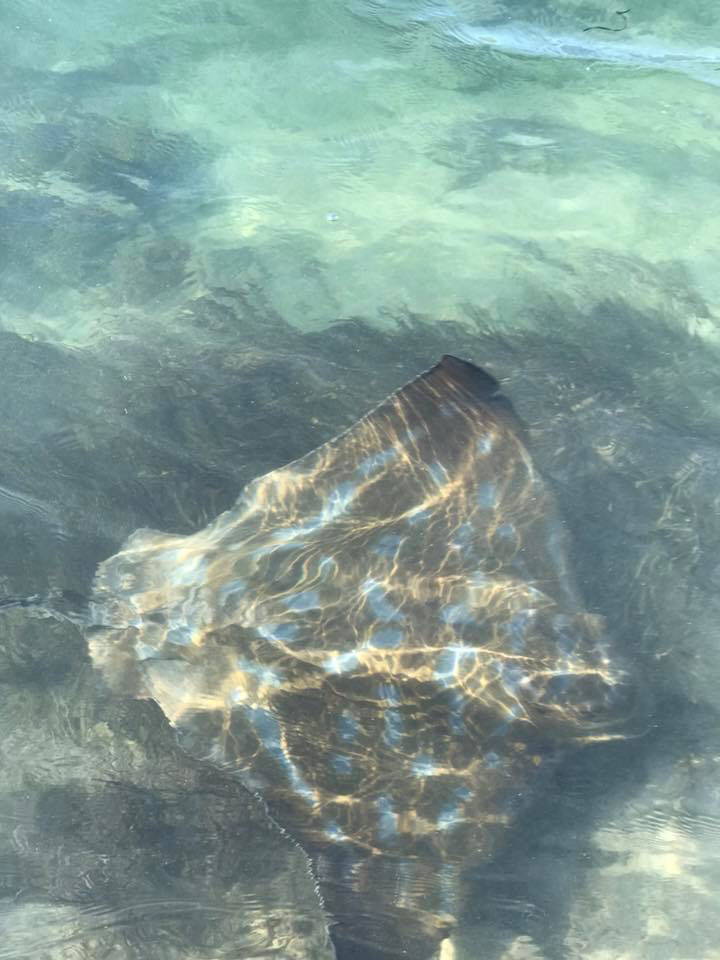
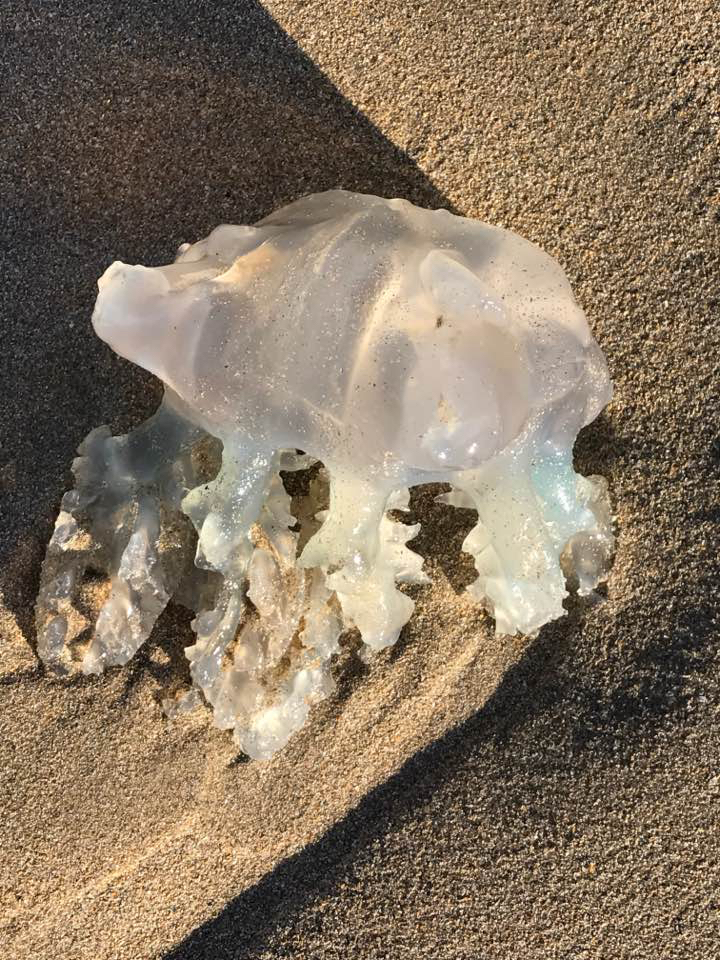



Very impressive and a great range of art works
Wonderful. Great concept, great work 🙂
Great people in a great article with fantastic photos. Well done to all involved. 🙂
Powerful powerful and moving and healing.
Thanks